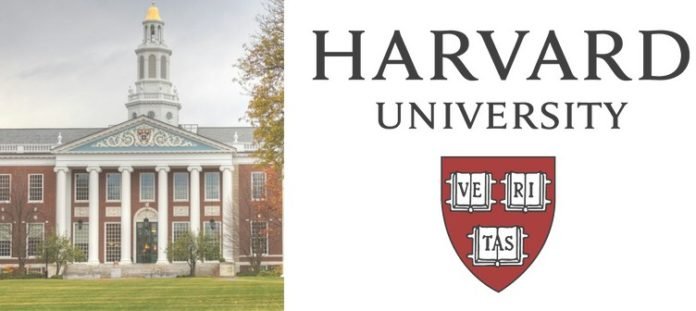This is a look at Harvard Logo and some history behind the school.
The Harvard University logo is a shield containing the Latin slogan “VERITAS” (“truth” or “verity”) on three books. Harvard adopted the Latin “Veritas Christo et Ecclesiae” motto in 1692, which means “Truth for the Church and Christ.” This slogan was placed on a shield and is found on many premises around the main campus, including Memorial Church, Widener Library, and a number of dorms within the Harvard Yard.
Harvard University is America’s oldest higher learning institution, having been founded in 1636. The Ivy League school is also one of the most prestigious in the country. The main campus lies along the banks of the Charles River, Cambridge, Massachusetts. It’s several miles west of the Boston central business district and has a total enrollment of around 23,000.
Remarkably, the two main books on the Harvard shield face up while the book at the bottom faces down. This signifies the need for the Almighty’s revelation and limits of reason. With the school having been secularized, the present shield now only has the name “Veritas” and three open books.
Harvard Logo Emblem
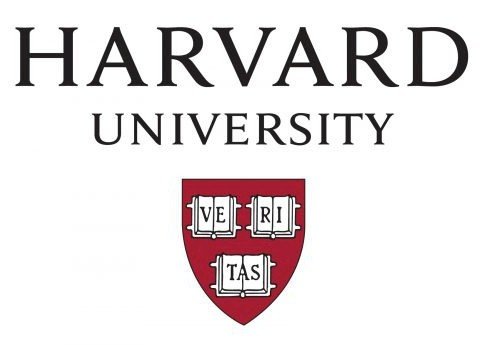
Apart from the standard emblem of the university, each of the twelve Harvard undergraduate houses has its own shield. The shields represent something of note about each house.
For example, the Currier House shield portrays “Radcliffe Apple Tree,” wherefrom Currier House got its sponsorship. The shields of Lowell and Eliot Houses have the Lowell and Eliot family’s coat of arms, respectively, while the Pforzheimer House shield is a mix of two colors—black represents Radcliffe, while crimson represents Harvard.
Harvard Logo Evolution
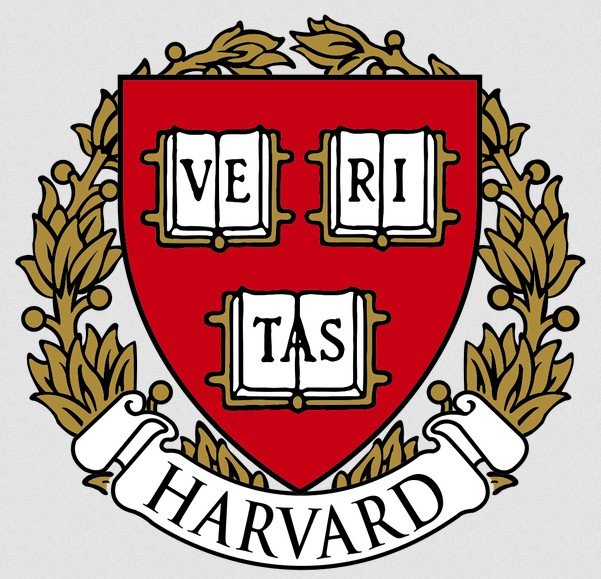
The original shield image of the Harvard logo was only unveiled on their bicentennial in 1836. This is when the shield we know today started appearing on-campus buildings. Harvard President John Quincy came up with the coat of arms in September of that year, and during their bicentennial festivities, the design was done on a banner and then hung in a huge tent.
In 1843, Harvard officially adopted the seal, which has stayed the same since then.
The shield and phrase appear across the campus—whether it’s embedded in royal statues, carved in the front gates, or placed on the front door of academic buildings. The Harvard emblem is powerful and oozes the integrity and history of the institution as a whole.
Harvard Logo Design Elements
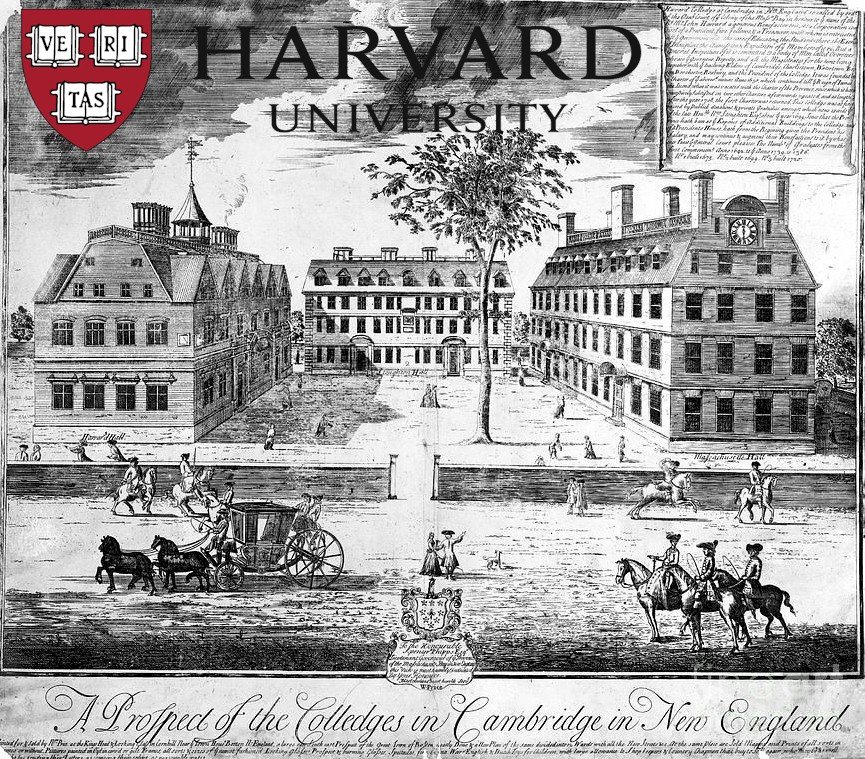 The Harvard logo is an emphatic display of honor, moral astuteness, and sophistication. And while the image has some variations, they’re all equally effective.
The Harvard logo is an emphatic display of honor, moral astuteness, and sophistication. And while the image has some variations, they’re all equally effective.
In most cases—on social media accounts and school websites—the logo is one angular shield in crimson. The red is deep and enchanting, while the shield’s shape oozes authenticity and strength.
This shield contains three books sitting open, and inside them are the characters that spell out the university’s motto. The word “Veritas” is written across all the open books to symbolize the value of learning, as well as its meaning to a successful and healthy society and moral compass.
The shield is circled by a wreath in some places, exuding class and sophistication. It’s a nod to a biblical period and further underscores the quest for truth, according to the Lord Almighty.
There are two books on top of the shield and one below. The third is indeed face-down—representing the limits to what the Lord can teach you and reason. That’s why the logo’s original designers made the image this way.
The Harvard logo is very simple, with subtle colors in use and little going on. But this doesn’t mean that the image doesn’t evoke any feeling.
The red crimson shade was made Harvard’s official color in 1890 after their rowing team started giving away crimson scarves. The college adopted this color for a good reason—the color is powerful and demands attention.
The dearth of other Harvard logo design elements places the focus on the phrase etched within. That’s important because the goal of establishing this school was to keep the quest for truth alive—in the arts, science, and more. By keeping the design simple and emphasizing truth and strength—the logo conveys a very direct and clear message.
The History Harvard University
Harvard University was established in 1636 through a piece of Massachusetts legislation. In 1636, the institution was labeled Harvard College, after a young cleric named John Harvard, its first main donor.
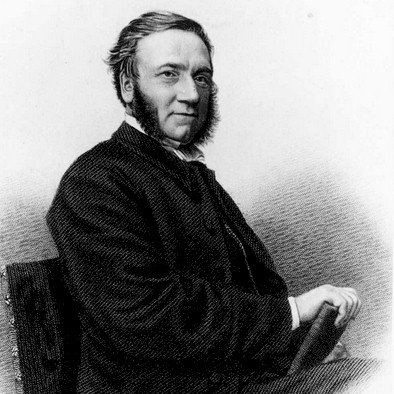
A graduate of England’s University of Cambridge, John Harvard bequeathed around 400 books to form the foundation of the institution’s library collection, as well as half of his own personal wealth, worth several hundred pounds. Harvard was first officially referred to as a “university” instead of a college in the new constitution of Massachusetts in 1780.
It’s believed that the whole point of establishing Harvard was to enable the training of local clergy so that there would be no need for the Puritan colony to depend on graduates from England’s Cambridge and Oxford Universities for well-trained pastors.
The link to the Puritans is evident in that, for its first centuries of operations, the institution’s board of overseers comprised the ministers of 6 local congregations (Cambridge, Boston, Roxbury, Dorchester, Watertown, Charlestown), as well as certain commonwealth officials.
Despite the Puritan air, from the off, the aim was to impart full liberal education like that provided at English varsities, including the basics of science and mathematics, as well as philosophy and classical literature.
Harvard was also set up to prepare American Indians for training as clergy among their tribes. In fact, there was a complex connection between missionaries to local tribes and Harvard. The first North American bible was printed at Harvard University in an Indian dialect, Massachusetts.
Dubbed the Eliot Bible because John Eliot translated it, this holy book was used to convert Indians, ideally by their Harvard-educated tribesmen.
Rise to Eminence
From 1800 to 1870, Harvard underwent a transformation, which E. Digby Baltzell branded “privatization.” The institution had thrived while Federalists run state government. In 1824, however, Jeffersonian Republicans finally defeated the Federalist Party and took away all state funding.
By 1870, the ministers and magistrates on the Harvard’s board of overseers were gone and had been replaced by the school’s alumni, drawn mainly from Boston’s upper-class professional and business community with funding from private donations.
During this time, Harvard experienced unmatched growth that elevated it to a higher category than other colleges. According to Ronald Story, Harvard’s total assets in 1850 were three times those of Yale, and five times those of Williams and Amherst combined. Indeed, by 1850, Harvard was a fully-fledged university with unequaled facilities. Also, Harvard was an early leading light in admitting religious and ethnic minorities.
While serving as the president of Harvard University between 1869 and 1909. Charles William Eliot completely transformed the varsity into a modern research institution. His reforms included entrance examinations, small classes, and elective courses. The Harvard model shaped American education all over the country, at both secondary and college levels.
The first black American Harvard alumni was Richard Theodore Greener, who graduated in 1870. Seven years later, Louis Brandeis graduated from the Harvard School of Law and later became the first Jewish judge in the Supreme Court.
The early 1900s for Harvard
In the mid-1880s, Harvard abolished compulsory chapel but stayed culturally Protestant. However, fears of dilution increased as more and more immigrants, Jews, and Catholics were enrolled in the early 1900s.
By 1908, 9 percent of freshman students were Catholics, and from 1906 to 1922, the enrollment of Jews at Harvard rose from 6 to 20 percent. In 1922, Harvard put in place a Jewish quota. This had been surreptitiously done by other universities.
Harvard President Lowell did it openly and spun it as a way of “dealing with” anti-Semitism, stating that there was a growing “anti-Semitic” feeling among Harvard students and that it was directly proportional to the rise in the Jewish population.
In fact, Harvard’s prejudiced policies, both overt and tacit, were in part responsible for the establishment of Boston College and Brandeis University in 1863 and 1948, respectively.
The Modern Era for Harvard
Throughout the 20th century, Harvard’s reputation grew worldwide as a burgeoning donation, and eminent scholars expanded the institution’s scope. Exponential growth in the number of students was experienced with the new graduate programs and the increase in the number of undergraduate courses.
In the decades following World War II, Harvard restructured its admission policies with the aim of attracting students from diverse areas and backgrounds. While the varsity’s undergraduates had largely been white, by the late 1960s, upper-class graduates from “feeder schools” like Groton and Andover and increasing numbers of working-class, minority, and international students had altered the socio-economic and ethnic composition of the university.
Nevertheless, the undergraduate population at Harvard remained mostly male, with around four males attending Harvard for every female attending Radcliffe College, established in 1879, as Harvard’s campus for women.
After Harvard and Radcliffe merged their admissions in 1977, more and more women began to enroll for Harvard degree programs, mirroring a national trend. Harvard’s graduate colleges, which had enrolled greater numbers of women and other groups even before Harvard itself, also got more diverse after World War II.
In 1999, Radcliffe formally merged with Harvard University. This established the Radcliffe Institute for Advanced Study.
Building on Radcliffe’s present programs and its continuing dedication to the education of society, gender, and women, the new institution is an interdisciplinary base where top scholars can promote scholarship and learning across a wide range of professional and academic fields within the environment of a top university. The school offers executive education programs and non-degree learning. The intention is to create a base for first-class advanced study.
While Harvard University made efforts to enroll minorities and women and get more involved with world and social issues, the focus on learning the critical thinking process over knowledge acquisition has seen the institution heavily criticized for abdicating its core responsibility and abandoning any effort to mold students’ moral character.
In the 21st century, there have been a number of additional adjustments and changes at Harvard University. The school is focusing on study abroad courses, offering students a range of opportunities to learn abroad. The institution has implemented a revised general education program that aims to connect classroom learning with real-world scenarios that students will find themselves in after school.
During this period, Harvard University has kept its outreach to bright students of different financial needs to make sure that the institution remains diverse. At present, there are just over 17,000 students enrolled in undergraduate programs and 30,000 students taking non-degree courses.
Notable Harvard Alumni

Over the course of its long history, Harvard University has produced many famous alumni, as well as a few disreputable ones. Among the most popular ones include political leaders such as John Adams, John Hancock, Franklin Roosevelt, Theodore Roosevelt, John F. Kennedy, and Barrack Obama.
Others include author Ralph Emerson, philosopher Henry Thoreau, poets T.S. Eliot, E.E. Cummings, and Wallace Stevens, actor Jack Lemmon, Mark Zuckerburg, Matt Damon, composer Leonard Bernstein, civil rights crusader W.E.B. Dubois, and architect Philip Johnson.
The university has also produced 75 Nobel Prize winners. Since 1974, 15 America Literary Award (Pulitzer Prize) winners and 19 Nobel Prize winners worked on the Harvard University Faculty.
Harvard Conclusion
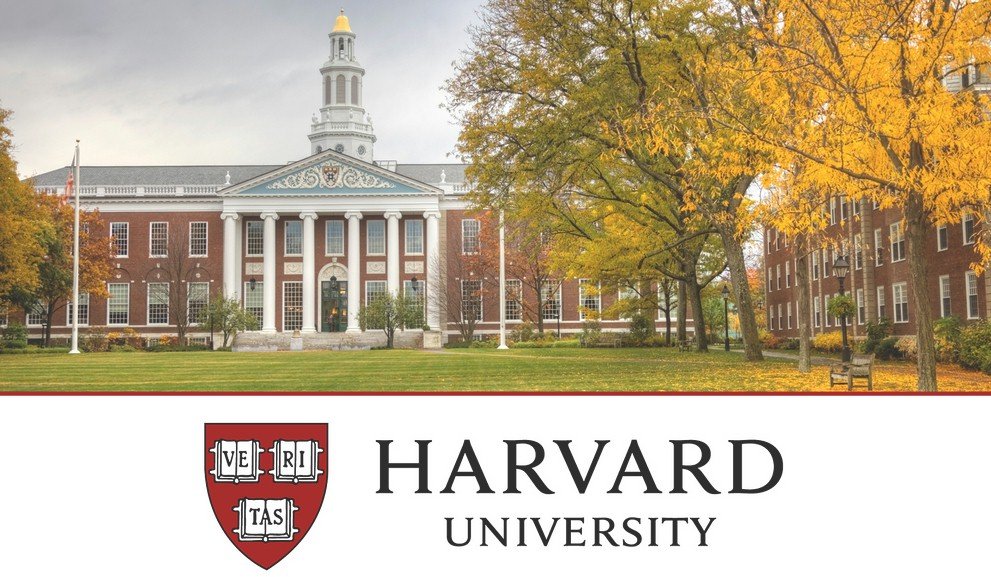 Harvard University was founded under church sponsorship, aiming to train clerics so the Puritan New England Colony wouldn’t need to hire immigrant clergy, but it wasn’t formally linked to any denomination. Harvard University finally freed itself from religious management and now focuses on offering the best academic scholarship and intellectual training, becoming popular for its focus on critical thinking.
Harvard University was founded under church sponsorship, aiming to train clerics so the Puritan New England Colony wouldn’t need to hire immigrant clergy, but it wasn’t formally linked to any denomination. Harvard University finally freed itself from religious management and now focuses on offering the best academic scholarship and intellectual training, becoming popular for its focus on critical thinking.
Despite facing heavy criticism on occasion, Harvard University has survived the tide of social change, granting admissions to women and minorities. Following demands by students for greater freedom in the 1960s, the institution of higher learning largely doesn’t meddle in the private affairs of its undergraduates. Harvard University continues its scholarly rivalry with Yale University and a complimentary, cooperative relationship with the nearby Massachusetts Institute of Technology.
An Ivy League member, Harvard University, maintains an excellent reputation for academic brilliance, with plenty of notable alumni and faculty.
——
If you are looking to redo or make your own School logo, LogoMyWay is the place for you. We have created thousands of logos and have logo designers from all over the world ready to help you with all of your logo needs. You can try our School Logo Maker free.
Harvard School FAQ
| What is Harvard’s motto? |
| Harvard’s motto is Veritas which stands for “Truth”. The motto was founded in 1643. |
| What does the Harvard logo stand for? |
| The president of Harvard Josiah Quincy came up with a rough sketch of the logo in 1836. The logo is a shield with the Latin phrase “VERITAS” or “TRUTH” placed on three books. |
| What is the Harvard mascot? |
| John Harvard, Also known as The Pilgrim. |
| Why is Harvard so good? |
| Harvard has many successful and famous Alumni. Harvard is known for teaching Science, Business, and Politics. These are just a few that have attended Harvard… Barack Obama, Al Gore, Ben Bernanke, Bill Gates, Conan O’Brien, Dean Norris, Franklin Delano Roosevelt, George W Bush, and many more. |
| Who owns Harvard? |
| Harvard is owned by a Board of members known as “Harvard Corporation” There are over 16,000 staff members and around 2400 professors and instructors that help run the school. |
| What GPA do you need to get into Harvard? |
| You need a minimum score on the SAT to be 1515, or 100 on the ACT. Your GPA must be at least 4.18 |

